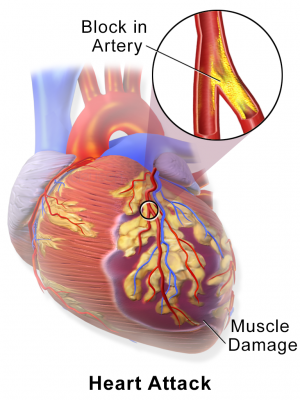Myocardial Infarction or Heart Attack. Credit: Blausen Medical Communications/Wikipedia/CC-A 3.0
Stem cell have been the main focus of healing therapy research because they can morph into new cells, and using a patient's own stem cells will not induce an autoimmune response. For healing after a heart attack, the ideal time to administer these therapies is when reopening the clogged blood vessel because the heart is easily accessible. While stem cells show promise for heart attack treatment, the process of harvesting and reintroducing the cells—which can take days or weeks—is too slow for this window. A new study in the American Journal of Physiology—Heart and Circulatory Physiology reports a more practical approach called microsphere therapy that can be kept on-hand and administered more readily than stem cells.
Heart attacks occur when the heart's blood vessel is blocked and blood flow stops, cutting off oxygen to the heart. Reopening the blocked blood vessel is the first step in treating the heart, but restoring blood flow is not enough to heal the heart. Oxygen deprivation damages the heart, and restarting blood flow can worsen the damage. Studies have reported that stem cells can effectively support the heart not by becoming new heart cells, but by releasing healing proteins, including ones that promote blood vessel growth.
Blood vessels are important for recovery because they give the body's repair processes access to the damaged regions. Specific proteins can stimulate blood vessels to grow back, but using proteins directly is not effective because they degrade easily and are difficult to store. To extend the shelf life of proteins, researchers from Erasmus Medical Center in the Netherlands used a biodegradable material called PolyActive, which keeps proteins intact, protects them from degrading and steadily releases them over a period of time. In addition, proteins in PolyActive can be stored without losing their effectiveness.
For this study, the researchers combined blood vessel growth protein vascular endothelial growth factor (VEGF) with PolyActive to form microspheres and tested the microspheres' effectiveness in pigs with induced heart attacks. The researchers observed that the microspheres were not toxic and stayed in the heart for at least 35 days. The treatment reduced inflammation that occurs after blood flow is restored and promoted blood vessels to regrow. The therapy, however, did not improve heart function. It also did not decrease the size of the area damaged by the heart attack or the composition of the scar. According to the researchers, while the method needs to be optimized, the study shows that microsphere therapy can potentially be an "off-the-shelf and immediate alternative to stem cell therapy" for treating heart attacks and potentially other diseases.
More information: "VEGF165A microsphere therapy for myocardial infarction suppresses acute cytokine release and increases microvascular density, but does not improve cardiac function." ajpheart.physiology.org/conten … .00698.2014.full.pdf
Provided by American Physiological Society























